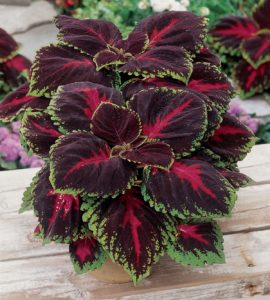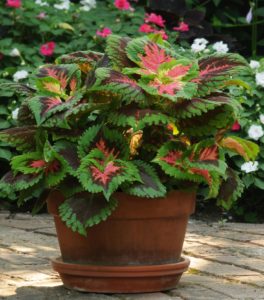Not all eye-catching plants in the garden flaunt flowers. Some like coleus (Solenostemon scutellarioides) decorate the landscape with a colorful tapestry of variegated foliage. This spring and summer, light up your garden with easy-to-grow coleus.

Today’s coleuses come in a wide variety of stunning color combinations. You’ll find variegated leaves featuring deep purple edged in green, lime green coleus with a hint of burgundy and multi-colored selections displaying pink, green and even chartreuse. While many coleuses grow best in shade, there are varieties that take full sun. Coleuses can also be successfully grown indoors as houseplants.
Find coleus in the nursery as grown plants, or try growing your own from seed. To have luck with coleus in the garden, keep the following tips in mind.
Plant in containers. Coleuses are tender, tropical plants originally from Southeast Asia and Malaysia, so they do best potted, as this keeps the roots warmer than when you plant them in the ground. Growing coleuses in containers also enables you to more easily transition them indoors once temperatures hit 65 degrees or below outdoors in the fall.
Pot coleuses in high-quality potting soil that provides moisture retention, yet drains well.
Provide proper lighting. Many varieties of coleus do best when grown in bright shade or dappled sunlight, as their delicate foliage will burn in direct sun. If you wish to grow them in direct sunlight, choose a cultivar developed for full sun, such as
PanAmerican Seed’s ‘Chocolate Mint’ and
‘Watermelon’ coleuses.
Place indoor grown coleus in a location that receives bright light, such as in a southern or eastern window, or under full-spectrum lighting.
Water properly. The soil of coleus should remain moist but never soggy. When the top ½ inch of soil dries out, soak the pot well. Coleuses that receive insufficient water will lose leaves, becoming spindly and unattractive.
 Fertilize regularly
Fertilize regularly. To keep them healthy and actively growing, coleuses require feeding every two weeks from spring through late summer or early fall. For best results, use an all-purpose, organic, liquid fertilizer.
Prune often. Coleuses become rangy and unruly if not pruned on a regular basis. Pinching out the growing tips, which are the sets of two to four leaves at the tip of each branch, encourages plants to branch out and become bushy. Also remove flower stalks when they appear. If you overwinter coleus indoors, prune the plant back by one-third in early spring before placing it outdoors.
Seed your own. If you wish to plant coleus seed, keep in mind that it will take about six weeks for the seed to germinate and create plants that are large enough to plant in containers. It’s best to start the seed indoors in the late winter or early spring.
Julie Bawden-Davis is a garden writer and master gardener, who since 1985 has written for publications such as Organic Gardening, Wildflower, Better Homes and Gardens and The Los Angeles Times. She is the author of seven books, including Reader’s Digest Flower Gardening, Fairy Gardening, The Strawberry Story, and Indoor Gardening the Organic Way, and is the founder of HealthyHouseplants.com


 Fertilize regularly. To keep them healthy and actively growing, coleuses require feeding every two weeks from spring through late summer or early fall. For best results, use an all-purpose, organic, liquid fertilizer.
Prune often. Coleuses become rangy and unruly if not pruned on a regular basis. Pinching out the growing tips, which are the sets of two to four leaves at the tip of each branch, encourages plants to branch out and become bushy. Also remove flower stalks when they appear. If you overwinter coleus indoors, prune the plant back by one-third in early spring before placing it outdoors.
Seed your own. If you wish to plant coleus seed, keep in mind that it will take about six weeks for the seed to germinate and create plants that are large enough to plant in containers. It’s best to start the seed indoors in the late winter or early spring.
Julie Bawden-Davis is a garden writer and master gardener, who since 1985 has written for publications such as Organic Gardening, Wildflower, Better Homes and Gardens and The Los Angeles Times. She is the author of seven books, including Reader’s Digest Flower Gardening, Fairy Gardening, The Strawberry Story, and Indoor Gardening the Organic Way, and is the founder of HealthyHouseplants.com
Fertilize regularly. To keep them healthy and actively growing, coleuses require feeding every two weeks from spring through late summer or early fall. For best results, use an all-purpose, organic, liquid fertilizer.
Prune often. Coleuses become rangy and unruly if not pruned on a regular basis. Pinching out the growing tips, which are the sets of two to four leaves at the tip of each branch, encourages plants to branch out and become bushy. Also remove flower stalks when they appear. If you overwinter coleus indoors, prune the plant back by one-third in early spring before placing it outdoors.
Seed your own. If you wish to plant coleus seed, keep in mind that it will take about six weeks for the seed to germinate and create plants that are large enough to plant in containers. It’s best to start the seed indoors in the late winter or early spring.
Julie Bawden-Davis is a garden writer and master gardener, who since 1985 has written for publications such as Organic Gardening, Wildflower, Better Homes and Gardens and The Los Angeles Times. She is the author of seven books, including Reader’s Digest Flower Gardening, Fairy Gardening, The Strawberry Story, and Indoor Gardening the Organic Way, and is the founder of HealthyHouseplants.com
